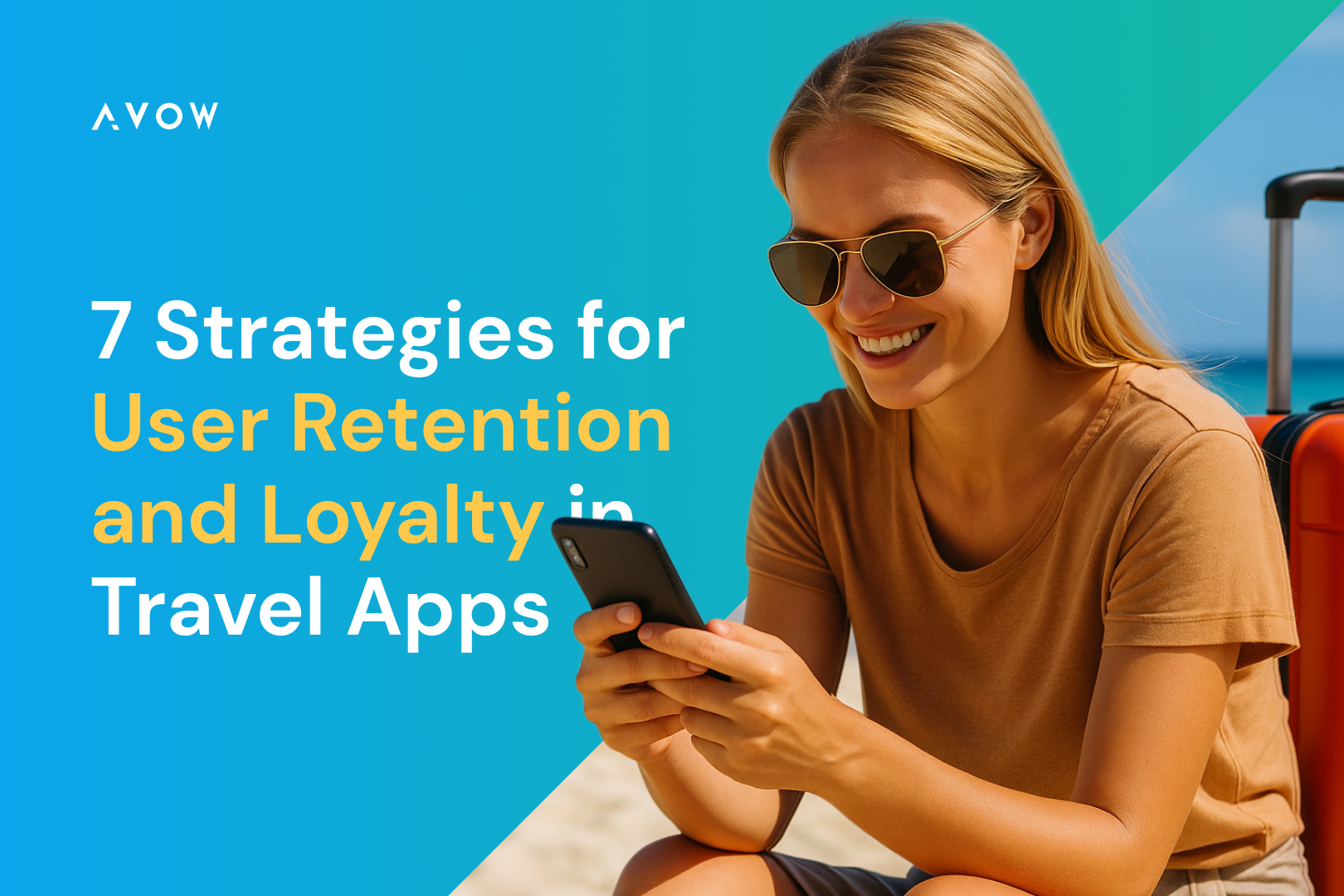The worldwide average income per download within the travel application sector is anticipated to grow by 21.28% from 2023 to 2027. To capitalize on this potential, app retention must be prioritized.
In today’s fast-paced travel industry, competition for user attention is intense. For a travel app to stand out, attracting users is just the beginning—the real challenge lies in retaining them and fostering loyalty. User retention not only boosts customer lifetime value (CLV) but also directly impacts growth through repeat usage, positive word-of-mouth, and, ultimately, higher profitability.
Here are seven proven app retention strategies to help travel apps maintain users and turn them into loyal advocates.
Craft an irresistible onboarding experience
A global study revealed that 25% of mobile applications downloaded by users were opened just once after download.
When users first download a travel app, they’re often eager to explore its offerings but may need clarification about navigation or feature benefits. The onboarding experience is critical here—it sets the tone for how users feel about your app and whether they’re likely to return.
To make a memorable first impression, focus on a seamless, visually engaging onboarding process that highlights core features. Use concise tutorials, interactive prompts, or visual tours to make them feel at ease. Apps like Airbnb and Booking.com use interactive onboarding to showcase unique features, simplifying first-time navigation and helping users immediately grasp the app’s value.
Pro Tip: Integrate a “skip” option, allowing users to bypass onboarding if they’re already familiar with your app or prefer a more exploratory experience.
Personalize content for relevance and engagement
The majority of top marketers, accounting for 90%, believe that personalization plays a crucial role in enhancing the profitability of a business.
Travelers increasingly expect customized experiences, and personalization is key to achieving this. By analyzing user behavior, preferences, and past bookings, you can offer tailored content such as destination recommendations, preferred travel dates, or even activity suggestions based on users’ interests.
Consider how well Netflix’s recommendation engine works; travel apps can implement a similar model by suggesting deals and locations based on browsing history or saved preferences. Personalization not only encourages usage but also fosters a sense of relevance, making users feel understood and appreciated.
Pro Tip: Send push notifications with personalized offers, like discounted trips or holiday suggestions that align with users’ interests. It’s an effective nudge without feeling intrusive.
Incorporate gamification elements
Apps that use gamification can boost customer loyalty by up to 300% and double referral traffic. You should embrace this strategy to improve your app retention rate.
Gamification can transform your travel app into an engaging platform users love returning to. Techniques like loyalty points, badges, and rewards for specific actions can keep users motivated to interact with your app. Some travel apps reward users for sharing their travel experiences, booking through the app, or completing certain challenges, like exploring new destinations.
Take the example of TripAdvisor’s “Travelers’ Choice” awards and review badges that incentivize users to share their experiences. By offering achievements, your app can encourage user contributions and re-engagement, driving organic traffic and loyalty.
Pro Tip: To keep users interested throughout the year, create seasonal challenges or interactive events, such as “Earn 500 points for booking a holiday package by December.”

Photo by Rana Sawalha on Unsplash
Send smart, well-timed push notifications
It’s interesting to note that mobile app engagement can increase by up to 88% through the use of push notifications. Additionally, enabling push notifications ensures that 65% of users revisit an app within the first 30 days. There is a strong reason why implementing this strategy is good for boosting app retention rates.
Push notifications can be a powerful tool for re-engagement, but timing is everything. Sending notifications at the wrong moment can disrupt users and may even prompt them to turn off notifications entirely. Instead, aim for messages that are both timely and relevant, helping users make the most of your app without feeling pressured.
For example, if a user has a trip coming up, a reminder about their flight details, check-in times, or travel itinerary can enhance their experience. Or, if they browsed weekend getaway packages last week, a well-timed alert about a new discount on nearby resorts might prompt a booking.
Pro Tip: Avoid overwhelming users with notifications. Find the balance by testing different timings and content to see what engages without irritating them.

Photo by JESHOOTS.COM on Unsplash
Offer exceptional in-app support
Customers who have a positive customer service experience are 38% more likely to recommend the business compared to those who have had a negative experience.
Travelers face many uncertainties, and when they need assistance, easy access to support can make all the difference. For travel apps, in-app support like live chat, 24/7 customer service, or even a well-organized FAQ can build user confidence, as they know help is just a click away.
Apps like Hopper provide AI-powered customer support that quickly answers questions or resolves booking issues. The convenience of real-time support reassures users and helps build trust. Quick, reliable responses in times of need can increase the likelihood of users returning, knowing they’ll receive help when they need it most.
Pro Tip: Provide location-based support for users who may face travel disruptions, like flight delays or cancellations, offering immediate assistance options directly within the app.
Use loyalty programs to boost engagement
Did you know that 65% of a company’s income is generated from the repeat purchases of current customers?
Loyalty programs are a tried-and-true method for encouraging repeat bookings and fostering long-term relationships with users. Offering reward points, discounts, or perks like free upgrades can motivate users to stay engaged. It’s especially effective in travel, where even small incentives—like discounts on hotels or exclusive deals on car rentals—can sway user decisions.
Apps like Expedia and Marriott Bonvoy reward users for each booking with points that can be redeemed on future travels. It not only gives users a reason to return but also adds an element of excitement, as they can accumulate points toward a reward.
Pro Tip: Allow users to see their loyalty progress or rank within the app, creating a sense of achievement and giving them a visible reason to keep using your service.

Embrace feedback loops and continuous improvement
A 5% increase in customer retention can lead to a 25-95% profit increase.
Your users are your most valuable resource for understanding what works and what doesn’t. Encouraging feedback through in-app prompts or periodic surveys can give you insights into user preferences, pain points, and areas for improvement. By consistently acting on feedback, you show users that their voices matter, strengthening their loyalty to your app.
For example, Airbnb frequently uses feedback to enhance its app’s usability, whether it’s adding filters for specific types of accommodations or improving in-app navigation. Users appreciate apps that listen and respond to their needs as they enhance their experience over time.
Pro Tip: After implementing a new feature, prompt users to share their thoughts—whether through a simple thumbs-up or down rating or a short questionnaire on the feature’s usefulness.
Beyond retention: The loyalty advantage
While app retention strategies focus on keeping users engaged, loyalty strategies create long-term advocates for your brand. By combining personalized experiences, well-timed interactions, and features that reward engagement, travel apps can forge strong relationships with users, who will, in turn, recommend the app to others.
Retention and loyalty are intertwined, but each requires a unique approach. Retention is the foundation, ensuring users remain active and engaged, while loyalty solidifies a lasting bond. When travel apps can achieve both, they’re well-positioned for sustained success in a crowded marketplace.
Conclusion
The ultimate goal for any travel app is to transform one-time users into loyal advocates. This journey requires a blend of creative engagement strategies, valuable rewards, and continuous improvement that shows users you’re dedicated to enhancing their experience. Whether through a seamless onboarding process, personalized recommendations, or a loyalty program that feels rewarding, each interaction should bring users closer to your brand.
Remember, app retention isn’t about making users feel tied to the app; it’s about giving them reasons to keep coming back. When you combine a thoughtful user experience with incentives that matter, you’ll not only retain users but turn them into lifelong advocates for your app.
Ready to grow your travel app’s user base? Implement these retention and loyalty strategies, and watch your app become a go-to travel companion for users everywhere!
Are you eager to enhance the visibility of your travel app? Collaborate with AVOW and leverage the potential of mobile OEM advertising to connect with millions of users at the most crucial touchpoints. Kickstart an increase in app downloads and user engagement right away!
Want to unlock the full blueprint of how to build and market a travel app? Discover all the secrets in our Ultimate Guide to Building and Marketing a Travel App!
About the Author






